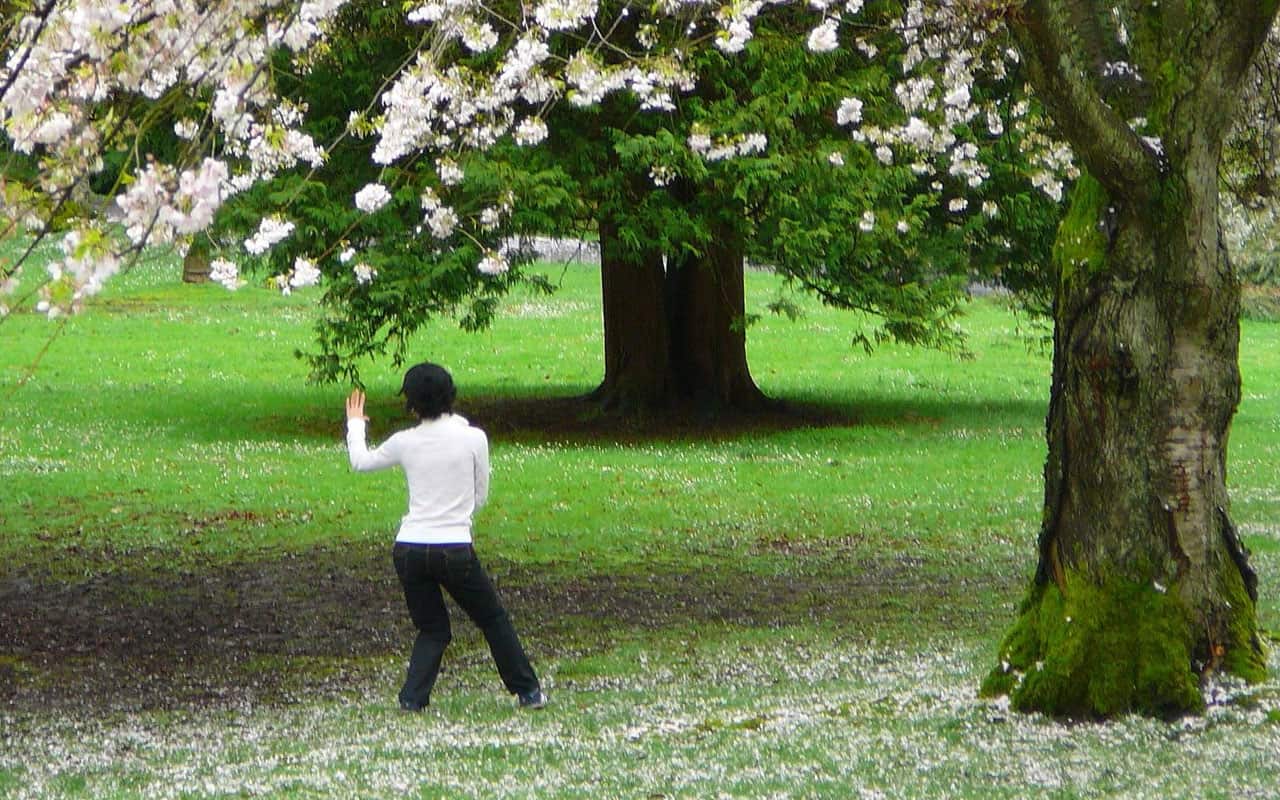Tai Chi and Taekwondo are both popular martial arts, however, not many people could accurately describe the difference between them. And as with most other martial arts as well, there are a lot of misrepresentations of both of these styles. We have spent quite a lot of time dissecting different martial arts at a surface level and trying to explain the differences between them and their level of effectiveness on the street (Goju-Ryu vs Shotokan, Aikido vs Taekwondo…), but we haven’t yet written about Tai Chi in comparison with any other style. We believe it is an art that certainly deserves its due, so here we go Tai Chi vs Taekwondo and the major differences between them.
Although both martial arts are mostly long-range, they are very different from one another since Taekwondo is a conflict-oriented, striking-based art, whereas Tai Chi is an internal, harmony- and peace-based art.
Arts like Tai Chi are often misrepresented, as we have mentioned before, so in this article, aside from discussing the history and the main building blocks of Tai Chi, we will also explain why, albeit very different from Taekwondo, it isn’t ineffective or a scam either. There is a lot to be said about these two arts, so if you are interested in learning about them, read on for more!
What Are the Differences Between Tai Chi and Taekwondo?
We will talk about the difference in techniques and philosophy, but first, in order to gain insight into the nature of these arts and to be able to put them into the right context, we have to look at their histories. Let’s start with the older one of the two, Tai Chi.
Tai Chi has a very long history and is arguably the parent art of all other Eastern martial arts. Like all other ancient styles, its founding and the founder itself cannot be pinpointed, seeing as it is an art form that was developed presumably over centuries by many different people. The Chen-family is nevertheless widely credited as creating the parent style of the five traditional styles of Tai Chi practiced today. Chen Wangting is one of the largest figures in Tai Chi history since he is said to have developed this parent-style around the 16-17th century. Another theory suggests that a legendary Taoist and martial arts master, Zhang Sanfeng should be credited with creating Tai Chi, more specifically Tai Chi Ch’uan, around the 12th or 13th century, and that this is what gave rise to all later styles and Tai Chi traditions.
Tai Chi is characterized by long, large movements that focus on building balance and harmony in the body. It is called an internal martial art, not because of the cliché “fighting a war in yourself to become invincible” type of nonsense, but more as a sort of philosophical stance towards fighting and as a form of meditation as well. Meditation, in general, resembles some sort of an internal martial art, since you have to go to war with your own instincts and your own automatic thought processes, which is really hard to do. Tai Chi is often referred to as physical meditation, and amongst many other health benefits like better sleep and cardiovascular system, it also promotes mental clarity and focus.
Taekwondo is the other end of the martial arts spectrum, possibly only beaten by Kyokushin Karate in its aggressive philosophy and style. Taekwondo was created by the collaborative efforts of the 9 traditional Korean Kwons, as a way to create a unified Korean martial arts system after the second world war. These Kwons were teaching a mixture of Chinese, Japanese, and indigenous Korean martial arts, but not in any specific, standardized way. Choi Hong Hi is credited as being the main person at the forefront of this unification movement, who used his martial arts knowledge and experience as an army general to come up with his Theory of Power, in which he describes much of the basic concepts and foundational ideas that make up Taekwondo and its dynamic.
Taekwondo is characterized by long-range, mostly kicking, but also punching strikes, and traditionally some grappling as well, though not many grappling techniques were implemented from the traditional Japanese martial arts. The reason we said it is on the opposite end of the spectrum from Tai Chi is that it is centered around causing damage and taking out enemies with devastating force and power, overwhelming them with insanely powerful leg kicks in quick succession. It is one of the most long-ranged martial arts out there, which also constitutes its weak point, but more on that later.
Which is Better for Self-defense: Tai Chi or Taekwondo?
When choosing a martial art to train, the most important aspect a majority of people go for is self-defense effectiveness. Seeing as most, if not all martial arts were created with the aim to teach people how to defend themselves and be the best and strongest people they could be, this expectation is not an unrealistic one. In this section of today’s article, we will go ahead and compare Tai Chi and taekwondo in terms of effectiveness.
Though the answer is not this simple (it never is with martial arts), there is quite a clear winner in this category, and that is Taekwondo. The reason? Tai Chi isn’t even an art that is meant to be used for fighting or one that even can be used for fighting, at least not until you reach a certain level of proficiency in it, which takes years and years of practice.
A martial art developed by an army general who was also an experienced martial artist, with the help of 9 of the most important Korean martial arts schools of the 20th century, with a theory in mind which focuses on using Newtonian physics and rational thinking to come up with the most effective and overwhelmingly powerful ways to conquer an opponent. This sums up Taekwondo pretty well. On the other hand, you have Tai Chi, which is: a harmonious, soft martial art that is mostly trained for health benefits and longevity but can also be trained to the point where it can be effectively used for self-defense, with years of practice.
It is already clear to see from here why we state that Taekwondo is more effective on the street. It is meant to deal damage, and it is meant to deal a lot of it. It might not be the most effective martial art there is, at least not for self-defense, but it is still highly effective and definitely more effective than Tai Chi, which could be called a form of meditation more than a fighting style. Think of it as a mild-fighting-based Yoga more than a kickboxing-like combat system.
To not misrepresent Tai Chi, we have to say that it can be highly, highly effective in a self-defense scenario as well, but don’t expect your local dojo to provide that sort of training, and don’t expect it fast, either. With years of Tai Chi, you can learn to sense your own and your opponent’s balance so much, that you can literally throw them out of balance with minimal movements, and you can deliver massive strikes with not much effort at all, but this state of Tai Chi mastery is really, really hard to achieve. This is why, in a standard street fight, for the average person training in a Western dojo, Tai Chi should be among your last options if you want to be the beast of the street.
Which One Should You Choose: Tai Chi or Taekwondo?
Your final decision should be based on what your martial arts goals are, and also on the type and quality of training available in your area. If you have a sloppy, scammer-like Taekwondo dojo next to your home, but you have a high-class, traditional Tai Chi Ch’uan dojo a kilometer away, you should still choose the Tai Chi, because you will be getting something valuable for your money, but don’t expect to win the next UFC championship with that knowledge.
Tai Chi is a good basis or addition to an otherwise developed martial arts portfolio, but on its own, it is useless in modern, street terms. We like to put a lot of emphasis on developing your self-defense, since what is martial arts for if not for the protection of yourself and your loved ones? For this reason, we would recommend Taekwondo over Tai Chi, since it will not only make you train a lot harder on your leg muscles than you probably ever have in your life, and not only will you learn how to do a vertical kick, you will also have a dangerous weapon, ready to be deployed at any time necessary. This weapon will be you yourself, and you will feel confident, healthy, and if we are honest, quite cool too.

